
A handheld game console, or simply handheld console, is a small, portable self-contained video game console with a built-in screen, game controls and speakers. Handheld game consoles are smaller than home video game consoles and contain the console, screen, speakers, and controls in one unit, allowing people to carry them and play them at any time or place.

A platform game is a sub-genre of action video games in which the core objective is to move the player character between points in an environment. Platform games are characterized by levels that consist of uneven terrain and suspended platforms of varying height that require jumping and climbing to traverse. Other acrobatic maneuvers may factor into the gameplay, such as swinging from vines or grappling hooks, jumping off walls, air dashing, gliding through the air, being shot from cannons, using jet packs, or bouncing from springboards or trampolines. Games where jumping is automated completely, such as 3D games in The Legend of Zelda series, fall outside of the category.

The Magnavox Odyssey is the first commercial home video game console. The hardware was designed by a small team led by Ralph H. Baer at Sanders Associates, while Magnavox completed development and released it in the United States in September 1972 and overseas the following year. The Odyssey consists of a white, black, and brown box that connects to a television set, and two rectangular controllers attached by wires. It is capable of displaying three square dots and one line of varying height on the screen in monochrome black and white, with differing behavior for the dots depending on the game played. Players place plastic overlays on the screen to display additional visual elements for each game, and one or two players for each game control their dots with the knobs and buttons on the controller by the rules given for the game. The console cannot generate audio or track scores. The Odyssey console came packaged with dice, paper money, and other board game paraphernalia to accompany the games, while a peripheral controller—the first video game light gun—was sold separately.
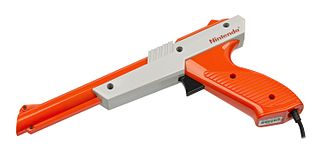
A light gun is a pointing device for computers and a control device for arcade and video games, typically shaped to resemble a pistol.

The Master System is an 8-bit third-generation home video game console manufactured and developed by Sega. It was originally a remodeled export version of the Sega Mark III, the third iteration of the SG-1000 series of consoles, which was released in Japan in 1985 with graphical capabilities over its predecessors. The Master System launched in North America in 1986, followed by Europe in 1987, and then in Brazil and Korea in 1989. A Japanese version of the Master System was also launched in 1987, which features a few enhancements over the export models : a built-in FM audio chip, a rapid-fire switch, and a dedicated port for the 3D glasses. The Master System II, a cheaper model, was released in 1990 in North America, Australasia and Europe.

A game controller, gaming controller, or simply controller, is an input device or input/output device used with video games or entertainment systems to provide input to a video game. Input devices that have been classified as game controllers include keyboards, mouses, gamepads, and joysticks, as well as special purpose devices, such as steering wheels for driving games and light guns for shooting games. Controllers designs have evolved to include directional pads, multiple buttons, analog sticks, joysticks, motion detection, touch screens and a plethora of other features.

Contra is a run and gun video game developed and published by Konami, originally developed as a coin-operated arcade video game in 1986 and released on February 20, 1987. A home version was released for the Nintendo Entertainment System in 1988, along with ports for various home computer formats, including the MSX2. The arcade and computer versions were localized as Gryzor in Europe, and the NES version as Probotector in PAL regions.
Shooter video games or shooters are a subgenre of action video games where the focus is almost entirely on the defeat of the character's enemies using the weapons given to the player. Usually these weapons are firearms or some other long-range weapons, and can be used in combination with other tools such as grenades for indirect offense, armor for additional defense, or accessories such as telescopic sights to modify the behavior of the weapons. A common resource found in many shooter games is ammunition, armor or health, or upgrades which augment the player character's weapons.
The Control-Vision is an unreleased video game console developed by Tom Zito. It is notable for using VHS tapes rather than ROM cartridges, prompting the creation of game content which survived on into much more advanced CD-ROM platforms.
An interactive film is a video game or other interactive media that has characteristics of a cinematic film. In the video game industry, the term refers to a movie game, a video game that presents its gameplay in a cinematic, scripted manner, often through the use of full-motion video of either animated or live-action footage.

The Cassette Vision is a second generation home video game console made by Epoch Co. and released in Japan on July 30, 1981. A redesigned model called the Cassette Vision Jr. was released afterwards.

An electronic game is a game that uses electronics to create an interactive system with which a player can play. Video games are the most common form today, and for this reason the two terms are often used interchangeably. There are other common forms of electronic game including handheld electronic games, standalone systems, and exclusively non-visual products.
A dedicated console is a video game console that is limited to one or more built-in video game or games, and is not equipped for additional games that are distributed via ROM cartridges, discs, downloads or other digital media. Dedicated consoles were very popular in the first generation of video game consoles until they were gradually replaced by second-generation video game consoles that use ROM cartridges.
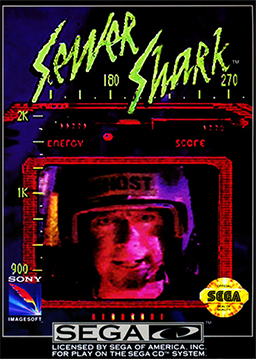
Sewer Shark is a first-person rail shooter video game, and is the first on a home console to use full motion video for its primary gameplay. It was originally slated to be the flagship product in Hasbro's Control-Vision video game system, which would use VHS tapes as its medium. However, Hasbro cancelled the Control-Vision platform, and Digital Pictures later developed the game for the Sega CD expansion unit. Sewer Shark is one of the first titles for the Sega CD and one of its best-selling games, leading Sega to eventually bundle it with Sega CD units. It was later ported and released for the 3DO in 1994. A port was also planned for the SNES-CD, but that system was cancelled.
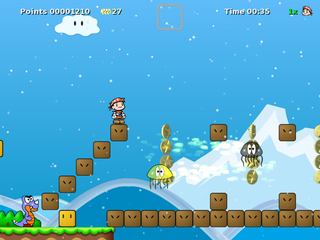
A side-scrolling video game is a game viewed from a side-view camera angle where the screen follows the player as they move left or right. The jump from single-screen or flip-screen graphics to scrolling graphics during the golden age of arcade games was a pivotal leap in game design, comparable to the move to 3D graphics during the fifth generation.
Light gun shooter, also called light gun game or simply gun game, is a shooter video game genre in which the primary design element is to simulate a shooting gallery by having the player aiming and discharging a gun-shaped controller at a screen. Light gun shooters revolve around the protagonist shooting virtual targets, either antagonists or inanimate objects, and generally feature action or horror themes and some may employ a humorous, parodic treatment of these conventions. These games typically feature "on-rails" movement, which gives the player control only over aiming; the protagonist's other movements are determined by the game. Games featuring this device are sometimes termed "rail shooters", though this term is also applied to games of other genres in which "on-rails" movement is a feature. Some, particularly later, games give the player greater control over movement and in still others the protagonist does not move at all. On home computer conversions of light gun shooters, mouse has been often an optional or non-optional replacement for a light gun.
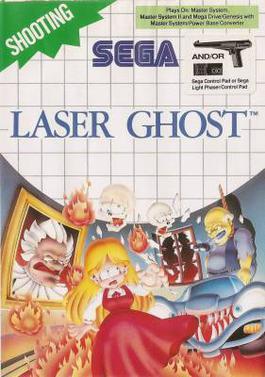
Laser Ghost is a horror-themed light gun shooter arcade video game released by Sega in 1990. The game is patterned after the films Ghostbusters and Poltergeist III, casting the player as a ghost hunter. There are three mounted guns set up on the cabinet, representing the three members of a ghost hunting team. The game puts the players in the role of Bill, Max and Carol, who must rescue a little girl kidnapped by a blue gargoyle, as well as protect the city from the ghost menace. A Master System game with the same title was released in 1991 exclusively for Europe, but was not based on the arcade original.
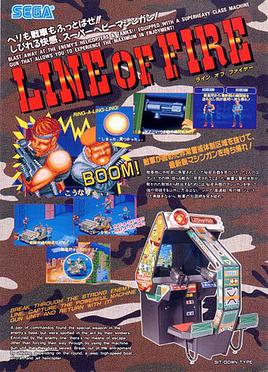
Line of Fire is a first-person light gun shooter game developed by Sega and released for arcades in 1989. It was released with two arcade cabinet versions, a standard upright and a sit-down cockpit, both featuring two positional guns. The cockpit design allows the player(s) to sit down while playing the game, while having two-handed machine guns, controlled by a potentiometer-controlled gun alignment software system. The game follows a two-man commando unit as they try to escape from a terrorist facility after seizing a prototype weapon.
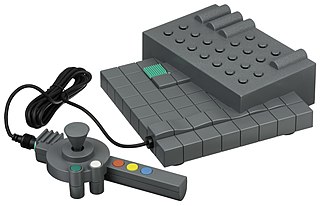
View-Master Interactive Vision is an interactive movie VHS console game system, introduced in 1988 and released in the USA in 1989 by View-Master Ideal Group, Inc. The tagline is "the Two-Way Television System that makes you a part of the show!" The titles include four Sesame Street games, two games featuring the Muppet Show characters, and a Disney game, Disney's Cartoon Arcade.
The Video Challenger is a home video game console that was produced by Takara in 1987. It uses special VHS tape-based footage that allows players to shoot targets with a ray gun.

















